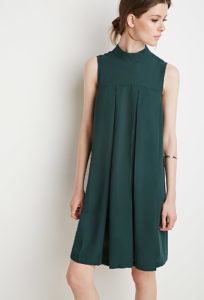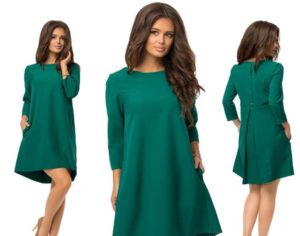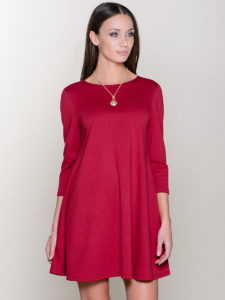 This style of dress appeared in the 60s of the 20th century, but the fashion for it has survived to this day. This is easily explained by its simple cut and universal use for both slender girls and plump women and pregnant women. It’s easy to sew it yourself, using a simple pattern as a basis and selecting suitable decorative elements.
This style of dress appeared in the 60s of the 20th century, but the fashion for it has survived to this day. This is easily explained by its simple cut and universal use for both slender girls and plump women and pregnant women. It’s easy to sew it yourself, using a simple pattern as a basis and selecting suitable decorative elements.
What is an a-line dress?
 The style is sewn according to a trapezoidal pattern, which tapers towards the shoulders and widens downwards. This model helps hide figure flaws, making the silhouette very feminine. Modern designers have developed a number of options “a la trapezoid” and in a new-fangled style. All of them are equally practical and cute, and always remain fashionable and popular. In them, a woman can be elegant even when expecting a child.
The style is sewn according to a trapezoidal pattern, which tapers towards the shoulders and widens downwards. This model helps hide figure flaws, making the silhouette very feminine. Modern designers have developed a number of options “a la trapezoid” and in a new-fangled style. All of them are equally practical and cute, and always remain fashionable and popular. In them, a woman can be elegant even when expecting a child.
On a note! A wide variety of fabrics are suitable for sewing. The most traditional are linen, fairly thick knitted fabric, cotton or staple material.
It is best to have several light sundresses and a-line dresses in your wardrobe for all occasions.
At the same time, linen sundresses and summer dresses will look great with natural wooden jewelry and natural stones. Pair with flats and solid heels, as well as bright sandals.
Heavy drape and knitwear are worn with boots with high tops or demi-season shoes such as ankle boots.
How to make a dress pattern correctly
 Women often strive to sew their own outfit. The simple cut of the trapezoidal style contributes to this. You just need to take a piece of material in accordance with the length of the pattern. Then measure the circumference of the chest and mark this simple diagram directly on the fabric.
Women often strive to sew their own outfit. The simple cut of the trapezoidal style contributes to this. You just need to take a piece of material in accordance with the length of the pattern. Then measure the circumference of the chest and mark this simple diagram directly on the fabric.
Required Tools
To sew a trapeze dress you will need:
 paper sheets for cutting;
paper sheets for cutting;- transfer paper Whatman paper;
- slate pencil;
- transfer wheel;
- cutting scissors;
- tailor's meter;
- a piece of soap;
- needles of different sizes;
- sewing threads;
- sewing machine;
- overlock machine.
Now you can proceed to the next stage.
How to take measurements for a dress correctly
In order for the pattern to be successful and the dress to fit well on the figure, you should take the necessary measurements correctly:
- posture should be familiar;
- use one bra when taking measurements and during fittings;
- first mark the waist line in the narrowest place with a belt in accordance with the floor line, then the length of the product in front and back will be identical;
- measure the volume of the thoracic region at the extreme points of the mammary glands in accordance with the waist line;
- Measure the volume of the femur at the widest possible point.

Next, we proceed directly to constructing the pattern.
How to make a trapezoid dress pattern with your own hands
If the fabric has a large-scale pattern of round or geometric shapes, then it should be adjusted at the side seams of the front and back panels. Such a procedure will inevitably require additional footage of fabric. You shouldn't forget about this when going to the store. In this situation, the back is cut first, and then the front accordingly.

Mandatory elements of an a-line dress
A product of this style certainly includes:
- Front part – one piece. with a hem.
- Back part – one piece. with a hem.
- Sleeve parts – two pieces. (if necessary).
- Parts for turning the back of the neckline - 2 pcs.
- Parts for turning the front part of the neckline - 2 pcs.
Step-by-step construction of a pattern
Beginning seamstresses should not take on a dress with a complex cut. The best option would be a simple and uncomplicated cut.
To build it you need:
- measure the chest and divide the resulting number into four parts;
- set aside this size on the top side of the paper sheet;
- accurately measure the length of the segment from the shoulder girdle to the armpit;
- apply a mark on the same sheet of paper and connect it perpendicular to an existing mark;
- measure the waistline, divide the resulting result into four parts;
- mark the data on the left side of the paper sheet;
- measure the segment from the chest to the waist line, and then mark it with a dot on the perpendicular;
- draw a straight line connecting this mark to the waist line to create a trapezoidal shape;
- draw a neck recess;
- mark on a piece of paper a point of the desired length of the product;
- connect the waist line with it, drawing a straight line down, gradually widening the hem;
- build the front part of the dress in the same way, placing additional darts on it;
- for everything to work out as it should, a straight line is drawn from the edge of the neckline to the bottom of the armhole, adding 5 cm and a dot at the end;
- then, from this mark towards the side cut, draw a rectangular figure with equal hips and a base of 2 cm;
- the resulting pattern is applied to the fabric.
A-line dress pattern with sleeves
The classic model from the last century, beloved by women, is an unsurpassed outfit for our contemporaries. It is distinguished by its convenience and beauty, and is very useful for the office, and for the evening promenade, and for restaurant relaxation.

Sewing a style with sleeves includes a number of stages:
- measure the length required for the sleeves, mark the result on a piece of paper;
- measure the volume of the forearm, add 10 cm to this number and mark it on a piece of paper;
- connect the existing points with two perpendiculars;
- measure 15 cm from the overlying straight line and draw a horizontal line;
- divide it into two equal parts and draw a vertical line through the center;
- create a triangular figure from the very top to descending straight lines;
- Divide the resulting sleeve halves again into two parts each and apply vertical lines along the entire length;
- draw an arcuate line to the bottom from the edge on the right to the vertical so that it moves 2 cm away from the triangular figure;
- perform the same manipulations on the left side, but it should only move away from the triangle by 0.5 cm;
- to the right of the central part of the triangular figure to the vertex mark, draw an arcuate segment in the upper direction (it should go to the side by five millimeters);
- draw an armhole;
- Use scissors to cut out the resulting elements - the one on the right will be the front, the one on the left will be the back.
Tips on how to sew an a-line dress using a pattern
When sewing, you must follow the following sequence:
 Iron all cut elements to ensure even seams.
Iron all cut elements to ensure even seams.- Before processing by machine, baste the darts on the chest on the arms.
- Baste the front and back main pieces on the sides and shoulders, then machine stitch.
- The details for turning the front and back neckline are sewn along the edge, joining at the shoulder seam.
- Armhole sleeve cutouts are trimmed in the same way, joining under the armpit.
- If the cut includes sleeves, they are sewn in as usual.
- A double hem is made along the edge of the hem, pressed with an iron and machine stitched.
- Finally, the seams are processed using an overlocker.
- After this, they are ironed away from the front and back, on the shoulders - towards the back.
- The dress is ironed and decorated.
The unique trapezoidal outfit is delicate and original. It is perfect for both thin and plump people. It is usually sewn from fabric, but it can also be knitted. In general, there are no difficulties with its manufacture. Everything is quite simple and is done in several stages. Even a novice dressmaker can easily cope with this task.


 paper sheets for cutting;
paper sheets for cutting; Iron all cut elements to ensure even seams.
Iron all cut elements to ensure even seams. 0
0





